ASUS F2A85-V Pro Review: A Look at FM2 with A85X
by Ian Cutress on October 10, 2012 11:20 AM EST- Posted in
- Motherboards
- Asus
- Trinity
- FM2
- A85X
USB Speed
For this benchmark, we run CrystalDiskMark to determine the ideal sequential read and write speeds for the USB port using our 240 GB OCZ Vertex3 SSD with a SATA 6 Gbps to USB 3.0 converter. Then we transfer a set size of files from the SSD to the USB drive using DiskBench, which monitors the time taken to transfer. The files transferred are a 1.52 GB set of 2867 files across 320 folders – 95% of these files are small typical website files, and the rest (90% of the size) are the videos used in the Sorenson Squeeze test.
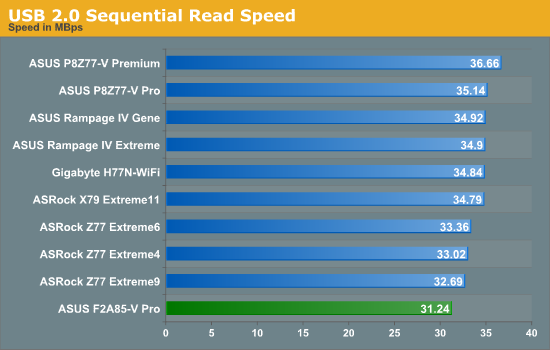
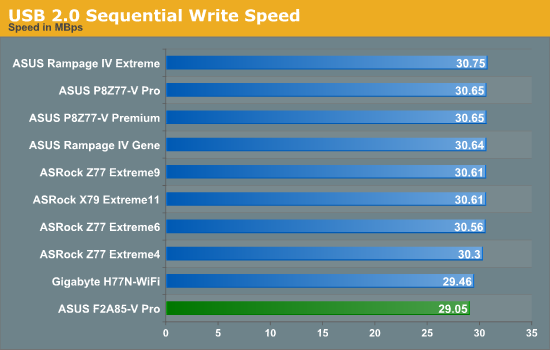
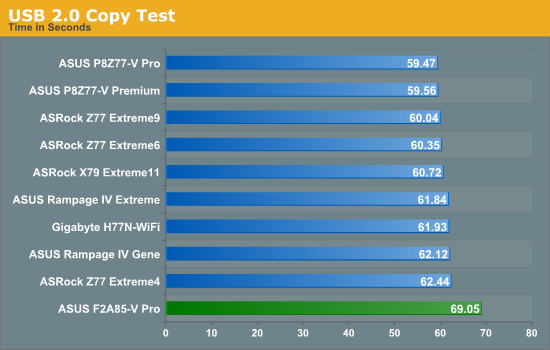
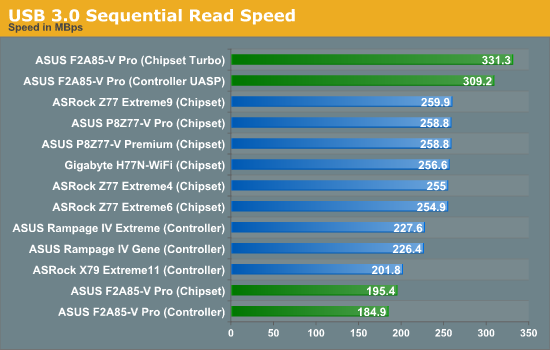


For whatever reason, our standard USB testing regimen on AMD systems shows a slight speed deficiency compared to the Intel systems. In USB 3.0 our copy tests are more than 10% slower on an AMD system.
SATA Testing
We also use CrystalDiskMark for SATA port testing on a C300 drive. The sequential test (incompressible data) is run at the 5 x 1000 MB level. This test probes the efficiency of the data delivery system between the chipset and the drive, or in the case of additional SATA ports provided by a third party controller, the efficiency between the controller, the chipset and the drive.

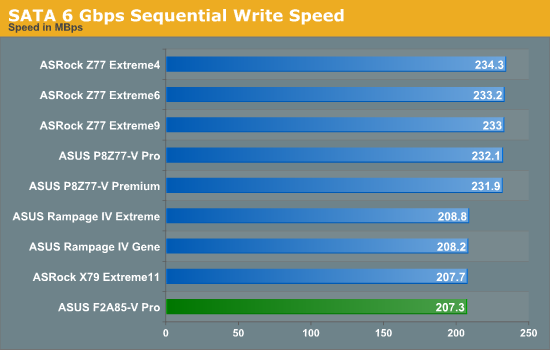
I really like the fact that the AMD chipset is SATA 6 Gbps only, although we see that SATA peak write speeds on this board are slightly lower than that of most Intel boards. Previously this is normally attributed to BIOS settings at default.
DPC Latency
Deferred Procedure Call latency is a way in which Windows handles interrupt servicing. In order to wait for a processor to acknowledge the request, the system will queue all interrupt requests by priority. Critical interrupts will be handled as soon as possible, whereas lesser priority requests, such as audio, will be further down the line. So if the audio device requires data, it will have to wait until the request is processed before the buffer is filled. If the device drivers of higher priority components in a system are poorly implemented, this can cause delays in request scheduling and process time, resulting in an empty audio buffer – this leads to characteristic audible pauses, pops and clicks. Having a bigger buffer and correctly implemented system drivers obviously helps in this regard. The DPC latency checker measures how much time is processing DPCs from driver invocation – the lower the value will result in better audio transfer at smaller buffer sizes. Results are measured in microseconds and taken as the peak latency while cycling through a series of short HD videos - under 500 microseconds usually gets the green light, but the lower the better.
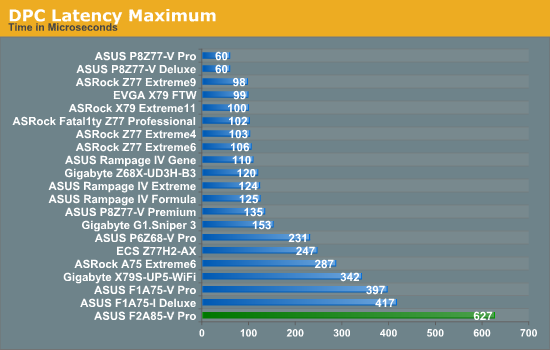
Normally our DPC Latency tests can be affected by monitoring software, producing a value north of 1000 microseconds. Anything under 500 is acceptable, and under 200 is great. However the F2A85-V Pro gets a value in the 600s. During the test, the DPC would hover between 100 and 200 most of the time, but every now and again would peak in the 600 region for whatever reason. The system was rebooted a couple of times but this behavior was persistent across boots. As of the 5104 BIOS this would be slightly worrying for audio work.










66 Comments
View All Comments
IanCutress - Wednesday, November 28, 2012 - link
1) Interestingly enough it is not a reviewers job to debug. I do correlate my results to the manufacturers, but I test on the latest publicly available BIOS at the time of testing. If I sat around waiting for 'the next BIOS' then each review would take 3x as long and I couldn't feed my family. Sorry to disappoint. (Also, not all reviewers are masculine as per your pronoun usage.)2) The USB 3.0 and SATA 6 Gbps are both native on Intel and AMD unless specified otherwise. I believe it is an appropriate comparison. People deciding to upgrade will want a comparison between what is available now in the market, not what was on the market. There is scope for editorials to look at how certain dynamics have changed over the years, but also tests change. My old data for 9xx chipsets is not relevant here.
3) Again, tests change over time in order to correlate with newer hardware and test the capabilities. If you have the spare time to dig out the hardware and run the newer tests, that's up to you. The other 14 motherboards I have in needed to be tested get priority here otherwise they become irrelevant. I would love to have infinite hardware and infinite time to do the comparisons, but that is not a logistical possibility.
4) Each chipset is tested against a single CPU. P67/Z68 was i5-2500K, X79 was i7-3960X, FM1 was A6-3650, FM2 was A10-5800K.
5) My apologies, next time I'll forgo the initial release review because it's the only board in my hand before release and wait a few months until I have six reviewed then post them at once when they become a little irrelevant.
6) Have you? Have you got time to do stability testing? What about testing it at high altitude, or in the Sahara?
If you believe there are things missing from the review, helpfully suggest additions for future consideration. My email is through my name on the review.
brookheather - Thursday, October 11, 2012 - link
Typo - "there is few reasons to jump on board to Trinity".Mugur - Friday, October 12, 2012 - link
Well, she was hot back in the first Matrix days... :-)silverblue - Thursday, October 11, 2012 - link
"With that being said, it is clear that video conversion is an INT process and all four of the A10-5800K INT units are being used"Are they, though? If so, it's a bit disappointing. Are all four threads maxed out in Task Manager? It'd be interesting to see a 4C/4T Intel processor thrown in there (2500K seems a perfect candidate) as well.
From looking at this, it should mean that an identically clocked Piledriver (83xx) CPU wouldn't be too far behind the 3770K in this one test. It does also mean, unfortunately, that even with linear performance scaling, even the top Piledriver CPU won't dethrone Thuban in the 3DPM MP test.
Soulnibbler - Thursday, October 11, 2012 - link
What does is this line in the performance section supposed to mean?QUOTE:
From a practical standpoint, the lack of floating point units in the CPU gives cause for concern as not everyone codes in hex or integer style (my own personal software all uses FP – INT would be confusing to code for me for negligible gain on most architectures).
/QUOTE:
I'm assuming you are referring to the bulldozer/steamroller architecture with a shared FPU unit per pair of integer units. On first reading it implies (and this implication is uncontested by the bizarre contents of of the following parentheses) that there is no floating point unit on the chip. That is patently wrong as there is a rather nice FPU shared between every two integer cores.
The other interpretation is that you think it needs MORE than half an FPU per core. That is an arguable point, but then the strange text in the parentheses paints you as someone who needs much more study towards what actually happens in a program. So much of your normal computing occurs in integer space. There isn't really any sort of program I can easily think of where you don't use integer operations (even memory mapping is integer) many times in order to prepare to do a single FP operation. The counter examples are all pretty much graphics examples where we want to work on vectors. The Trinity FPU has a nice vector processor too. If you break down and look at the machine code that any of your programs use you will find that an overwhelming (much greater than 66%) of that code is integer code.
Crying OH NOES 1/2 A FPU, is not good reporting. YES the AMD chips lag the Intel chips, YES the design parameters are different. The unfounded supposition that performance difference are due to that specific portion of the architectural choice is frankly bad journalism. If you want to make claims like that you have to point to a set of benchmarks that demonstrate clearly that the 1/2 FPUs are to blame. I doubt this is the case as most analysis that I've seen points to larger memory subsystem problems as a much bigger factor.
IanCutress - Wednesday, November 28, 2012 - link
If your supposition is true, then the A10-5800K should not experienced as much of a decrease against the competition as it did do in the results.My 3DPM results clear my position on the matter:
"In the single threaded test, a lot of conclusions can be drawn from the comparison of AMD architectures. Direct comparison of Piledriver to Bulldozer (A10-5800K to FX-8150) gives a boost in single core performance of 7%, however comparing the old Stars cores of the A8-3850 at 2.9 GHz is roughly the same as the new Piledriver core at 4.2 GHz. So even with a 1.3 GHz advantage, Piledriver is only as good as Stars and less efficient in floating point results. If we compare Piledriver to Thuban, i.e. A10-5800K to X6 1100T, the Piledriver core gets stomped on by a good 25% performance. I find this quite staggering – most of the code I ever encountered as a computational chemist was floating point based, dealing with single and double precision on a regular basis. On this result, I would steer clear of Piledriver.
The multithreaded version of 3DPM is slightly tougher to analyze. Due to the FP nature of the program, the A10-5800K is essentially a 2 core FPU processor, whereas all the other comparative AMD processors have either 4 or 6 FPUs to play with. What is perhaps worth considering is that the Bulldozer processor with 4 modules scores 326.32, whereas the Piledriver processor with only 2 modules scores 203.06, which is more than half. This would mean that the Piledriver core actually achieves 20% better performance at the same frequency, despite our ST test giving Piledriver only a 7% increase. Part of this could be put down to the architecture improvements – improved scheduling for heavily threaded loads, one of the downfalls of Bulldozer but was improved in Piledriver could be the reason here."
My basis for my comments is from a computational complexity standpoint. Sure memory mapping may be an int process, but if I only do it at the beginning and end of a matrix transformation (and thereby having a total processing time less than 0.1% of the program) then it becomes insignificant.
What AMD have done is project that applications in the future which require heavy computational throughput will be driven by INT ops. The big software vendors can do this, making video conversion and ray tracing type applications enhanced by use of INT ops. But for the non-CompSci scientist who relies more on readable code but also wants a speed increase, then going all out on the INT side may not be possible, and we get limited performance due to the scheduling and the lack of pure grunt due to the gutted APU. It's a design choice AMD have to live with, and I'm not the only one who is not entirely in favor of it.
Scootiep7 - Thursday, October 11, 2012 - link
Ok, I'm trying not to break down and just buy a Llano for my HTPC build, but does anybody know how much longer it'll be till I can get some nice options for a mini-ITX such as http://news.softpedia.com/news/MSI-Presents-FM2-A7... and the 5700k? What's the holdup on these!groundhogdaze - Thursday, October 11, 2012 - link
AMD should play to their strengths which is an affordable CPU with a relatively fast integrated GPU. That means focusing a small form factor systems such as AIO, ITX, HTPC class systems, however, I am surprised and disappointed at the relative lack of options when it comes to ITX FMx motherboards. I sold my AMD stock when I concluded they had their strategy wrong. Most folks who want to use a full sized case would also want to use a dedicated GPU, otherwise, what's the point of having a full sized case? Wrong marketing choice.Unless AMD can improve their heat/power ratings, the Intel G530 makes better sense as a NAS solution as it is dirt cheap and uses less power than its advertised 65w TDP while running circles around the Atom class processors. I hope AMD is reading the forums and best luck to them.
Mugur - Friday, October 12, 2012 - link
You are right. Full ATX and Trinity makes little sense. mATX and mini ITX with 8 SATA3 and integrated graphics should be the focus. Full ATX in fact makes little sense today, anyway... :-)If you want more than a NAS from a server, the best 65W Trinity part should be nice. I have a Phenom II X2 rated 80W in my HTPC and an Athlon II X4 (95W) in my server at home. Neither of them comes even closer to their rated TDP, according to the "green" ICs and software of the motherboards (Gigabyte and Asus).
silverblue - Friday, October 12, 2012 - link
AMD seems to volt their processors conservatively, so K10Stat (or other utilities) or using the BIOS to reduce the voltage may prove useful in reducing power consumption noticably without affecting performance more than a couple of percent.Toms ran an article on this as regards Trinity, and have done so with various AMD models in the past:
http://www.tomshardware.com/reviews/a10-5800k-trin...
Saving 14W for a tiny performance deficit is more than acceptable in my eyes.
I undervolted my Phenom II X3 710 as per the following article:
http://www.tomshardware.com/reviews/processor-powe...
(though I needed to raise voltages by 0.025v to keep it 100% stable in my case)